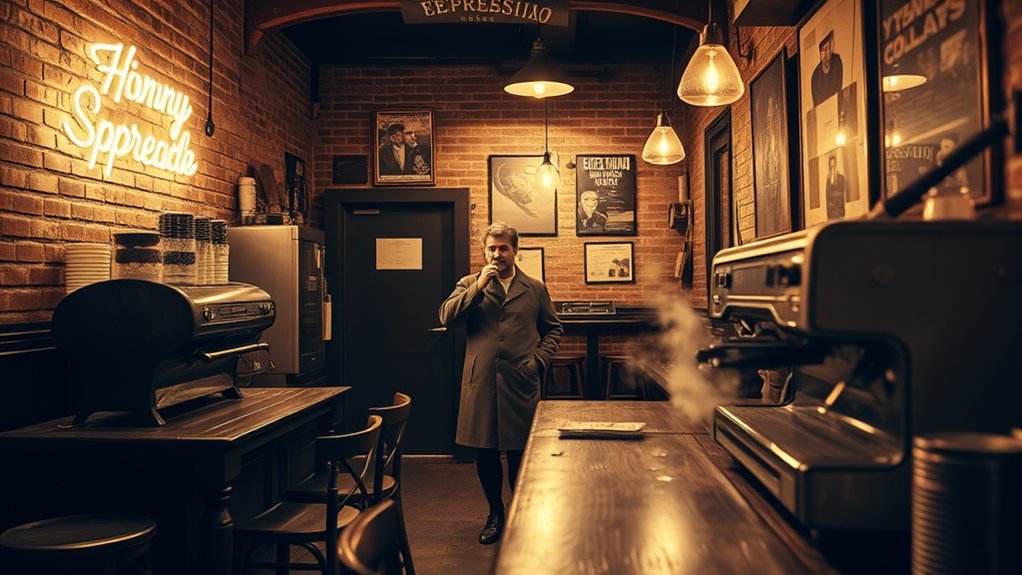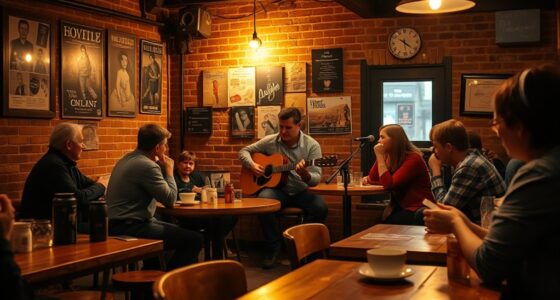In postwar Italian cinema, espresso bars act as vibrant symbols of cultural renewal and social change. These cafés are more than backgrounds; they embody shifts in society, often depicting moments of connection, tension, and everyday life. Filmmakers use their lively visuals to highlight themes of identity and optimism during Italy’s rebuilding era. If you explore further, you’ll discover how these settings reveal deep cultural and cinematic insights that shaped Italy’s storytelling.
Key Takeaways
- Espresso bars serve as iconic symbols of modern urban life, reflecting societal shifts in postwar Italian cinema.
- They function as social hubs where different classes interact, embodying themes of societal change and cultural renewal.
- Cinematic scenes emphasize realism through close-ups and vibrant visuals, highlighting the café’s role in narrative authenticity.
- Cafés in films depict social interactions, tensions, and the vibrancy of postwar urban society, enhancing storytelling depth.
- They symbolize Italy’s cultural revival, acting as visual and thematic microcosms of societal transition and new identity exploration.

After World War II, espresso bars emerged as vibrant symbols of modern urban life in cinema, reflecting shifting social dynamics and cultural identities. These cafés weren’t just places to grab a quick drink; they became cultural landmarks that embodied the changing landscape of postwar Italy. As you watch films from this era, you’ll notice how these spaces serve as more than mere backdrops—they represent a hub where social classes intersect, ideas flourish, and new lifestyles take shape. Their presence in cinema underscores their cultural significance, acting as visual symbols of a society in transition. Through these scenes, filmmakers communicate a sense of renewal, optimism, and the search for identity that defined the postwar period.
In terms of stylistic representations, espresso bars are often depicted with a deliberate visual clarity that emphasizes their role as modern, dynamic spaces. You might see close-ups of steaming cups, bustling crowds, or the flickering ambiance created by neon signs—elements that heighten the café’s vibrancy. These stylistic choices aren’t accidental; they serve to highlight the café’s significance as a microcosm of urban life. The camera work and mise-en-scène often focus on the interactions within these spaces, capturing the subtle tensions and camaraderies that define social relationships. This visual language allows filmmakers to explore themes of anonymity, intimacy, and societal change, all within the intimate setting of an espresso bar. The stylistic representations also reflect the aesthetic ideals of Italian Neorealism, emphasizing realism and everyday moments over romanticized or theatrical portrayals. This approach grounds the café scenes in authenticity, making them relatable and resonant for viewers. Additionally, the inclusion of authentic settings such as espresso bars contributes to the film’s overall realism and emotional impact.
Frequently Asked Questions
How Did Espresso Bars Influence Postwar Italian Social Life?
You see, espresso bars transformed postwar Italian social life by becoming vibrant urban gathering spots. They fostered social mobility, allowing people from different backgrounds to mingle easily. As you visit these cafés, you notice how they encourage casual conversations, breaking down social barriers. These bars became hubs of community, reflecting Italy’s shift towards a more open, interconnected society, making social interactions more accessible and dynamic.
What Role Do Cafes Play in Character Development?
You notice how cafes shape character development when you observe their ambiance and interactions. The lively, relaxed atmosphere invites genuine conversations, revealing personalities and emotions. Coincidences often happen over coffee, deepening relationships or exposing flaws. These settings become natural stages where characters evolve, making cafes essential to storytelling. They aren’t just backgrounds—they actively influence characters, making their journeys more authentic and relatable.
Are Espresso Bars Depicted Differently Across Various Italian Regions?
You’ll notice espresso bars vary across Italian regions, reflecting local dialects and architectural styles. In northern Italy, they often feature modern, sleek designs with regional dialect signage, while southern cafes embrace rustic, traditional architecture with distinct dialects in their menus. These differences highlight regional identities, making each espresso bar unique and authentic, enriching the cinematic portrayal of Italy’s diverse culture and social fabric.
How Did Café Interiors Reflect Postwar Italian Economic Conditions?
You’d think café interiors during postwar Italy would scream luxury, but irony has it that they mirror economic austerity instead. Sparse furnishings and utilitarian designs showcase a nation rebuilding on a tight budget. Yet, amid these modest spaces, urban revitalization pulses, turning cafés into lively hubs of hope and resilience. So, your favorite coffee spot quietly embodies Italy’s struggle and renewal, blending austerity with a spirit enthusiastic to revive itself.
Did Café Settings Impact the Narrative Structure of Neorealist Films?
You see that café setting markedly impacts the narrative structure of neorealist films by emphasizing urban ambiance and social interactions. These environments create a realistic backdrop where characters’ everyday struggles unfold naturally, highlighting their relationships and societal issues. The cafés serve as microcosms of postwar Italy, guiding story development through genuine conversations and interactions that reflect the characters’ lives and the broader social context.
Conclusion
So, next time you see an espresso bar in a film, remember it’s more than just a cozy setting—it’s a symbol of postwar Italy’s hopes and struggles. Ironically, those cafés that once represented resilience now often serve as mere backdrops for fleeting moments. You might find it amusing how a simple coffee spot can mirror a society’s complex journey, reminding you that sometimes, the most ordinary places hide the most profound stories.









